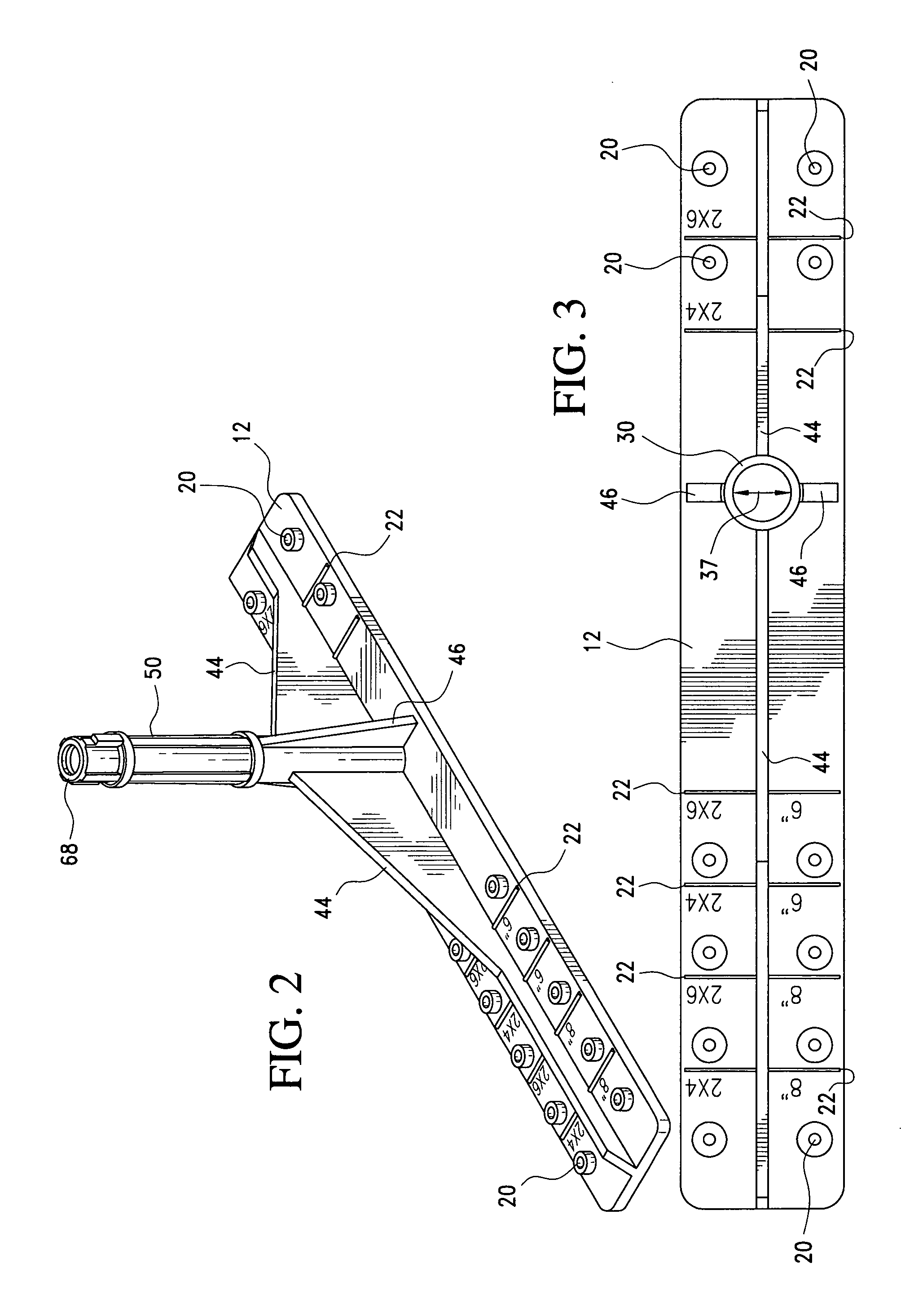Anchor bolt placement protection assembly and method for aligning structural elements in a form when pouring concrete
- Summary
- Abstract
- Description
- Claims
- Application Information
AI Technical Summary
Benefits of technology
Problems solved by technology
Method used
Image
Examples
first embodiment
[0039] the anchor bolt placement and protection assembly 10 of the present invention is illustrated in FIGS. 1-5. Referring now to FIGS. 1 and 2, anchor bolt placement and protection assembly 10 includes a substantially planar base plate or flange 12 having an upper surface 14 opposite a lower surface 16. In the illustrated embodiment, a base plate bolt aperture 18 is provided in the shape of a circle. Base plate 12 also includes a plurality of nail-receiving apertures 20 each including a raised collar portion dimensioned to receive and hold a nail placed within the collar in preparation for having that nail driven into a foundation form board or the like. The nail apertures 20 are preferably spaced at even increments selected to appropriately position base plate 12 in relation to form boards during a pour (e.g., as seen in FIG. 6).
[0040] Base plate 12 also includes, on upper surface 14, a plurality of substantially parallel spaced, transverse alignment indicia ribs 22 which can be ...
second embodiment
[0050] Referring now to FIGS. 7 and 8, the anchor bolt placement and protection assembly 140 includes a substantially planar elongated base plate 142 from which projects a perpendicular tubular member 144. Base plate 142 is preferably configured as a rectangular member having a plurality of transverse thru-bores or apertures including a plurality of nail receiving apertures aligned with a plurality of alignment indicia or centering guide indicators. A longitudinal reinforcing web or rib 146 preferably supports fixed tubular member 144 which is also supported by a plurality of reinforcing ribs 148 that extend vertically along the length of tubular member 144. Tubular member 144 preferably has a selected diameter 150 which is slightly larger than and closely fits with a selected size of anchor bolt shaft.
[0051] Base plate 142 is a substantially rectangular member having radiussed corners, a length of approximately twelve inches, a width of approximately one and three sixteenth inches ...
third embodiment
[0052]FIGS. 9-11 illustrate the anchor bolt placement and protection assembly 160 including a substantially planar base plate 162 from which projects a substantially perpendicular cylindrical tubular member adapted to receive and sealably engage with one or more extension sleeves (e.g. 166, 170) or, optionally, a threaded nut 168 all of which have a selected inside diameter adapted to receive and protect an anchor bolt shaft of selected size. When configured as shown in FIG. 10, extension sleeve 166 has a proximal or lower flange area which sealably engages the distal sealing surface 164 of tubular member 164 to seal out debris, cement and other material which may otherwise contaminate the outer surface of the anchor bolt shaft. Similarly, threaded nut 168 includes a proximal flange adapted to bear against and sealably engage the distal end of extension sleeve 166. As shown in FIG. 11, the tubular member inside diameter 172 is dimensioned to accommodate a selected size (e.g., ½″) an...
PUM
 Login to View More
Login to View More Abstract
Description
Claims
Application Information
 Login to View More
Login to View More - R&D
- Intellectual Property
- Life Sciences
- Materials
- Tech Scout
- Unparalleled Data Quality
- Higher Quality Content
- 60% Fewer Hallucinations
Browse by: Latest US Patents, China's latest patents, Technical Efficacy Thesaurus, Application Domain, Technology Topic, Popular Technical Reports.
© 2025 PatSnap. All rights reserved.Legal|Privacy policy|Modern Slavery Act Transparency Statement|Sitemap|About US| Contact US: help@patsnap.com



